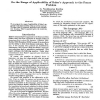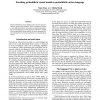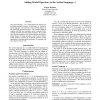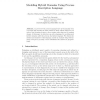CONSTRAINTS
2008
14 years 6 months ago
2008
We describe an approach to modeling biological networks by action languages via answer set programming. To this end, we propose an action language for modeling biological networks...
ECAI
2010
Springer
14 years 7 months ago
2010
Springer
Abstract. This paper puts forward a view on conditional commitments as causal rules, using action language K as the specification framework. The proposal builds upon an operational...
AAAI
1996
14 years 7 months ago
1996
We investigate the range of applicability of Baker's approach to the frame problem using an action language. We show that for temporal projection and deterministic domains, B...
AAAI
2004
14 years 8 months ago
2004
Pearl's probabilistic causal model has been used in many domains to reason about causality. Pearl's treatment of actions is very different from the way actions are repre...
NMR
2004
Springer
14 years 12 months ago
2004
Springer
The action language A is a simple high-level language for describing transition systems. In this paper, we extend the action language A by allowing a unary modal operator in the u...
ASP
2005
Springer
15 years 3 days ago
2005
Springer
In previous work, action languages have predominantly been concerned with domains in which values are static unless changed by an action. Real domains, however, often contain value...
ICLP
2007
Springer
15 years 21 days ago
2007
Springer
Abstract. Action description languages, such as A and B [6], are expressive instruments introduced for formalizing planning domains and problems. The paper starts by proposing a me...
CCIA
2007
Springer
15 years 22 days ago
2007
Springer
In this paper, we present an action language which is called AP oss in order to perform reasoning about actions under uncertainty. This language is based on a possibilistc logic pr...




